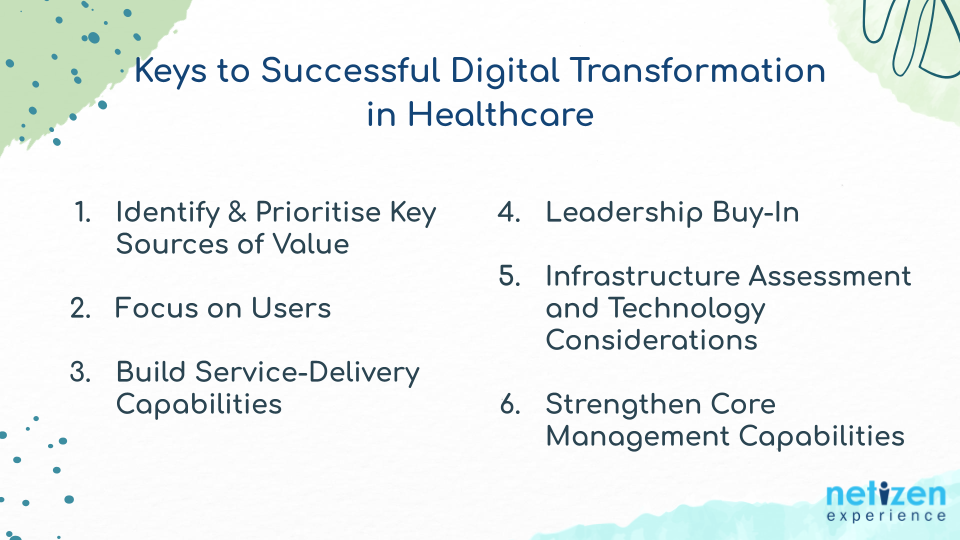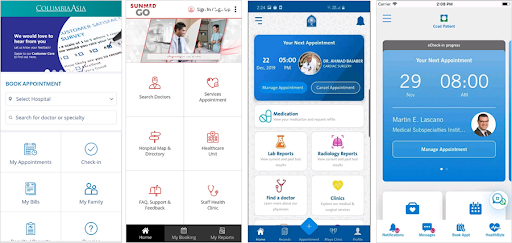We’ve explored the digital transformation of Asia’s smart hospitals and digital patient trends for 2021 as part of our digital healthcare series. Now, continuing on this series, we delve into the keys to successful digital transformation in healthcare.
In this series, we have come to understand that digital transformation is vital in keeping up with the ever-changing technological advancements around us. Patients’ expectations are growing and in this age of technology, successful digital transformation in healthcare is more important than ever.
Keys to Successful Digital Transformation in Healthcare
An increasing number of healthcare companies understand that digital technologies are not just beneficial but also strategic assets. However digital transformation isn’t as easy as hitting the ‘on’ button which is why we have identified several keys in order to have a successful digital transformation in healthcare.

Identify & Prioritise Key Sources of Value
The move towards digital transformation starts with identifying key sources of value, doing so helps to simplify the digital transformation process. The healthcare company can prioritise these key sources of value and adjust their investment and effort accordingly.
This also helps to focus the attention and drive the direction during the complicated digital transformation process. It’s impossible for a single healthcare company to be a jack of all trades. Spend time identifying your company’s key sources of value, perhaps it’s to focus on automation and cutting-edge technologies to improve efficiency? Or it’s to focus on preventative medicine and making use of data to mitigate health risks?
Once the key sources of value are properly identified and prioritised, the organisation can best determine how and where to invest in digital technologies in meeting those highest priorities.
For example, a pharmaceutical company may choose to prioritise their digital transformation towards their research effort and in doing so, build a digital platform in order to collect and analyze data, which can also help in conducting synthetic clinical trials and manage market access.
A definitive source of value that many healthcare companies are focusing on is getting close to users, to see from the patients’ perspective, which brings us to the second key for successful digital transformation.
Focus on Users
Digital transformation for users wouldn’t be effective without focusing on the users and aligning with them. Put yourself in their shoes, better yet, consider conducting user experience research to find out their existing pain points in order to have a clear idea on how best to improve. Are patients able to easily update their electronic health records? Does it motivate them to become active consumers of healthcare?
For healthcare stakeholders and digital transformation, usability is essential and key, it also helps to avoid digital fatigue. Digitisation is of no benefit if it serves to hinder rather than assist. In order to make sure that the digital transformation is advantageous, it’s vital to align to users’ needs and to ensure that it is easily usable for them.
Putting people at the centre of the digital transformation initiatives helps to lead healthcare companies down the right path, developing the right applications, processes and workflows.

Example of digital solutions currently provided by different healthcare providers that focus on making patient experience better and easier. For example, eliminating the long waiting time at the hospital through virtual queueing service.
Build Service-Delivery Capabilities
Understanding users is the first step to re-imagine the workflow and processes in order to build capable service-delivery. Agile development, customer experience design and data science are handy approaches for healthcare companies to utilise in building service-delivery capabilities.
Agile is a software development methodology in which involves short and fast phases of development, prototyping, reassessment and adaptation. The agile development approach works well with customer experience design and data science to elevate digital services.
Instead of working on a single large project as an outcome-drive process, an at-scale digital healthcare organisation can have up to 100 agile teams running concurrently, cutting down the timeline from years to a matter of months or weeks.
In order to do so, the organisational structure will need to be improved to build effective and efficient service-delivery capabilities and to keep up with the pace of digital transformation.
Combining agile operations with customer experience design and data science can yield significant results. Instead of following behind others playing catch up, it could give healthcare companies an edge in coming up with innovative solutions.
Leadership Buy-In
Digital transformation opens up an opportunity to re-imagine and revamp how the business works, and this can only be done with leadership buy-in, and with the support of all employees.
Organisational transformation is part of digital transformation, and leadership buy-in is key because those in leadership positions will be spearheading the digital transformation plan. It helps ensure that change efforts are under control and also minimises disruptions and unnecessary changes. Furthermore, less resistance fuels a smoother digital transformation process and helps to get everyone on the same page in understanding that digital transformation isn’t just a phase or an upgrade but a progressive and united step forwards.
Cultivating a willingness to change isn’t easy and leadership buy-in sets an example for employees to follow. If the company isn’t open to transformation, the transition will be detrimental and it won’t benefit any parties involved. Fostering a culture that is open to transformation helps to smoothen the entire digital transformation process and ensures a lasting success.
Infrastructure Assessment and Technology Considerations
Assessing and examining the IT infrastructure is key for a successful digital transformation, determining whether the infrastructure is capable of providing a reliable and strong backbone to digital transformation initiatives. If the IT infrastructure is incapable of supporting the speed and transparency in IT operations, the IT foundation needs to be modernised.
Aging or legacy systems may need to be abandoned entirely and a new and capable IT foundation built in to take its place. Especially to ensure that all the data is managed securely and that users can access said data seamlessly.
Technology considerations include governing access and data security, ensuring that strict cybersecurity policies are in place and that the IT infrastructure is capable of handling new technologies such as robotics, big data, IoMT (Internet of Medical Things), etc. Doing so will help to enable digital innovation and seamlessly deliver better healthcare services.
Data is the new currency, and IT infrastructure is like a bank. Any vulnerabilities in the IT infrastructure could be disastrous, which is why establishing a strong and reliable technological backbone is key.

Credit: Unsplash
Strengthen Core Management Capabilities
Large transformations like digital transformation require companies to strengthen and maintain core management capabilities, this largely includes talents and partnerships, financial processes and culture.
Healthcare companies must have capable talent in their staff to drive the digital initiative. In order to do so, existing recruitment will need to be assessed and improved to incorporate new skill sets and enhanced training needs. Looking beyond traditional talent sources may be necessary in order to find the right person for the job, which is why it’s important to develop partnerships with other companies to work together in furthering the industry.
Financial processes will need to establish dedicated funds for digital initiatives. Investment priorities must be clear, communicated and revisited regularly in order to stay updated. A formal governance structure should be established for stakeholders to make digital decisions, an external advisory board or internal governance council may be helpful.
Finally, strengthening culture is vital in establishing a healthy and productive work environment that is open to new ideas and technological advancements. Poor organisational health can lead to failed transformation efforts. Culture is so important in ensuring that everyone is on board in moving forward to the digital age.
This can be done by focusing all employees on five critical questions:
- Where do we want to move towards?
- How ready are we to move forwards?
- What must be done for us to get there?
- How will we manage the journey?
- How do we keep moving forward?

